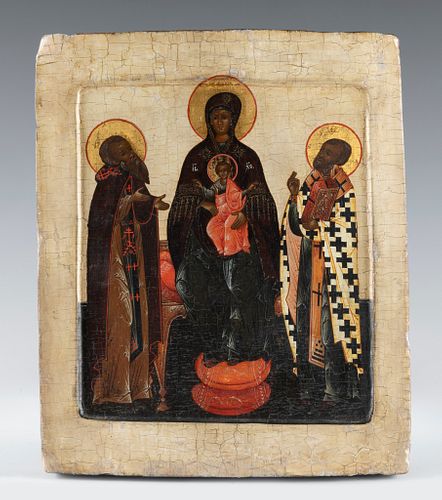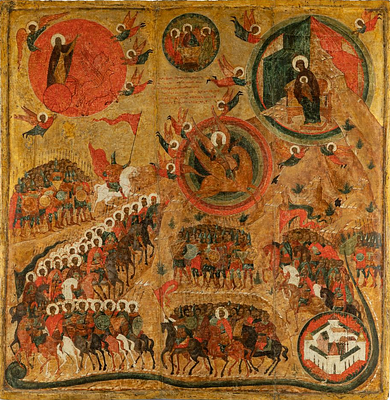Russian school, late 16th century. "The Virgin and Child Jesus and selected saints". Tempera, gold leaf on panel.
Lot 6
About Seller
Setdart Auction House
Carrer Aragó 346
Barcelona
Spain
Setdart Subastas was born in 2004 and is currently the first online art auction in Spain with solidity, prestige and reliability guaranteed by our more than 60,000 users. Setdart has a young, dynamic and enterprising team ready to successfully manage the purchase and sale of art works through custom...Read more
Estimate:
EUR€15,000 - EUR€18,000
$15,625 - $18,750
Absentee vs Live bid
Two ways to bid:
- Leave a max absentee bid and the platform will bid on your behalf up to your maximum bid during the live auction.
- Bid live during the auction and your bids will be submitted real-time to the auctioneer.
Bid Increments
| Price | Bid Increment |
|---|---|
| EUR€0 | EUR€10 |
| EUR€200 | EUR€25 |
| EUR€500 | EUR€50 |
| EUR€1,000 | EUR€100 |
| EUR€3,000 | EUR€200 |
| EUR€5,000 | EUR€500 |
| EUR€10,000 | EUR€1,000 |
| EUR€20,000 | EUR€2,000 |
| EUR€50,000 | EUR€5,000 |
About Auction
By Setdart Auction House
Sep 23, 2021
Set Reminder
2021-09-23 10:00:00
2021-09-23 10:00:00
America/New_York
Bidsquare
Bidsquare : RUSSIAN ICONS
https://www.bidsquare.com/auctions/setdart-auction-house/russian-icons-7431
Setdart Auction House sofia@setdart.com
Setdart Auction House sofia@setdart.com
- Lot Description
Russian school, late 16th century. "The Virgin and Child Jesus and selected saints". Tempera, gold leaf on panel. Measurements: 27 x 22 cm. The icon of interest represents a quite common and popular composition, of the Mother of God seated on the throne, with the selected saints. It follows the traditional model of a triangular hierarchical composition, where the seated Virgin is at the top, and of a larger size, than the rest of the saints. The two saints next to her are depicted in two different postures, the saint on the left holding the gesture of adoration, and the saint on the right raising his right hand in a gesture of blessing. The inscriptions on the figures are missing and have probably been lost, so there is some difficulty in identifying them. Certain characteristic features, such as the beards or the clothing, could indicate that the saints depicted are John Chrysostom on the right, and on the left is a venerable monk, which is suggested by his clothing and the multiple representation of the cross of Golgotha, a typology used exclusively on the clothing of orthodox monks. This type of depiction of the seated Virgin and Child is widely known in the Orthodox world under the name "Panachranta", and has similar features to the prototype "Odighitria" in depicting the faces of the Virgin and Child embracing, and with the faces side by side. The central image of the auctioned icon features the iconography typical of Panachranta, with the Virgin Mary seated on the throne, holding the Christ Child on her knees. The throne symbolises the majesty and royal power of the Mother of God. This prototype of the Virgin Mary and Child developed in the Byzantine Empire between the 11th and 12th centuries, and has been known in Russia since the 13th century. In compositional terms, this ancient icon presents one of the most particular features of Orthodox iconography, which is the reverse perspective. The throne, on which the Virgin rests, is depicted in such a way that the viewer can see it from several points of view at once. The idea behind the reverse perspective is not so much to represent a physical object from the most realistic and plausible point of view, but to convey the moment and the space in which the scene takes place with maximum depth, i.e. to present the objects on the two-dimensional support in such a way as if they were viewed from all points of view at the same time. The composition also focuses on the viewer's gaze, and on the importance of the viewer being somehow part of the interior of the image. The same idea is at the basis of Cubist painting, for example.
- Shipping Info
-
In-house shipping available. Please inquire at admin@setdart.com.
-
- Buyer's Premium



 EUR
EUR CAD
CAD AUD
AUD GBP
GBP MXN
MXN HKD
HKD CNY
CNY MYR
MYR SEK
SEK SGD
SGD CHF
CHF THB
THB















